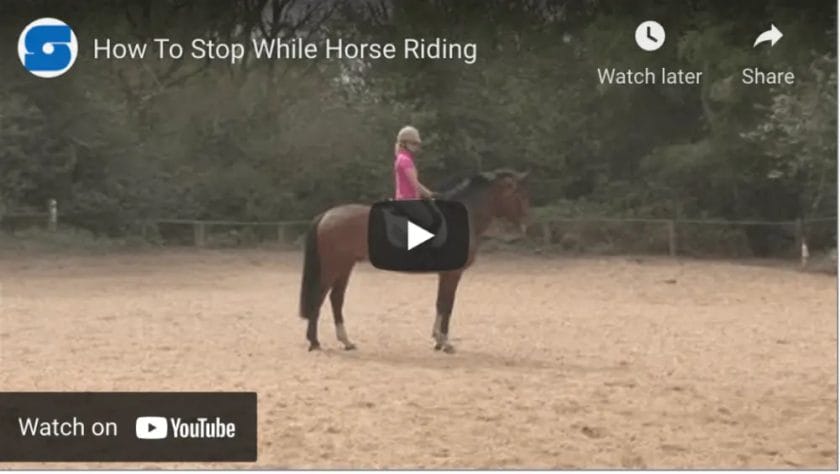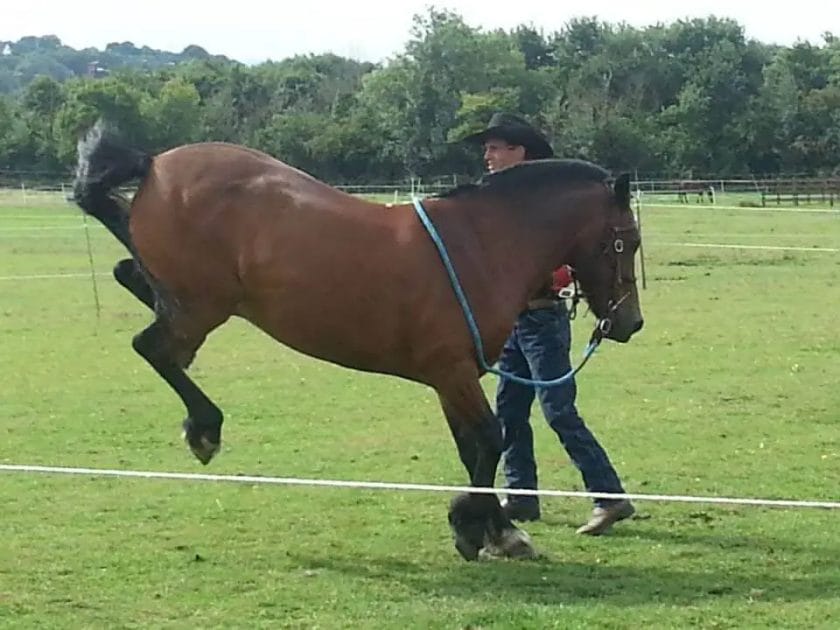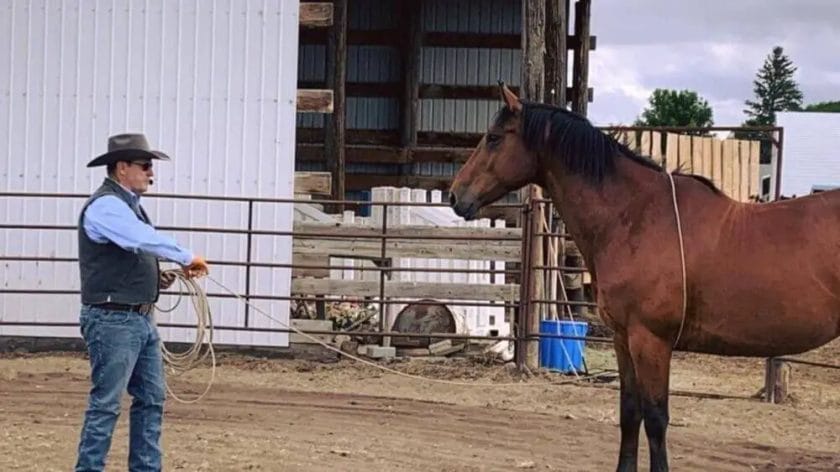If you’re looking for effective techniques to stop a horse, you’ve come to the right place. Whether you’re a beginner or an experienced rider, knowing how to safely and efficiently bring a horse to a halt is crucial. In this guide, we will explore different methods and cues to stop a horse, including both natural and trained responses. By understanding the horse’s body language and using proper aids, you’ll be able to confidently and smoothly halt your horse in any situation.

Common Mistakes When Trying to Stop a Horse
When it comes to horse training and riding, one of the most important commands to teach a horse is how to stop. However, many riders and trainers make common mistakes that can hinder the effectiveness of their stopping cues. In this section, we will discuss some of the common mistakes made when trying to stop a horse and provide tips on how to avoid them.
1. Inconsistent Rein Pressure
One of the biggest mistakes riders make when trying to stop a horse is applying inconsistent rein pressure. It’s important to remember that horses rely on consistent and clear signals to understand what is expected of them. If you apply varying amounts of rein pressure or release the pressure at different times, it can confuse the horse and make it difficult for them to understand the stopping cue.
To avoid this mistake, make sure to maintain steady and even rein pressure when asking your horse to stop. Apply firm but gentle pressure and hold it until the horse comes to a complete stop. Consistency is key in communicating with your horse.
2. Using Only the Reins to Stop
Another common mistake is relying solely on the reins to stop a horse. While the reins play a significant role in stopping, it’s important to remember that horses also respond to other cues, such as seat and leg aids. Using only the reins can create an imbalance and put excessive pressure on the horse’s mouth.
To avoid this mistake, make sure to use a combination of rein, seat, and leg aids when asking your horse to stop. Engage your seat by sitting deep in the saddle and apply gentle pressure with your legs to support the stopping cue. This will help distribute the pressure evenly and make it easier for the horse to understand the command.
3. Lack of Preparation and Consistency
A common mistake made by riders is a lack of preparation and consistency when asking the horse to stop. Horses are creatures of habit and thrive on routine. If you are inconsistent in your stopping cues or fail to prepare the horse beforehand, it can lead to confusion and a lack of response.
To avoid this mistake, establish a consistent routine and prepare the horse for the stopping command. Before asking the horse to stop, make sure they are attentive and responsive to your aids. Establish a clear and consistent stopping cue, such as a verbal command or a specific motion, and use it every time you want the horse to stop. Consistency will help your horse understand and respond to the cue more effectively.
4. Tension and Anxiety
Tension and anxiety are common mistakes that riders make when trying to stop a horse. If you are nervous or tense, the horse can sense it and become tense as well. This can make it difficult for them to respond to your cues and may even lead to resistance or disobedience.
To avoid this mistake, try to stay calm and relaxed when asking your horse to stop. Take deep breaths, maintain a confident posture, and trust in your training. Horses are highly attuned to our emotions, so cultivating a calm and confident demeanor will help create a positive environment for effective communication.
5. Ignoring the Horse’s Physical Condition
Lastly, a common mistake is ignoring the horse’s physical condition when trying to stop. If a horse is in pain or discomfort, they may have difficulty stopping or responding to cues effectively. Ignoring these physical cues can lead to frustration and confusion for both the rider and the horse.
To avoid this mistake, regularly assess your horse’s physical condition and address any potential issues promptly. Ensure that the horse is properly warmed up and comfortable before asking for a stop. If you notice any signs of discomfort or resistance, consult a veterinarian or equine professional to rule out any underlying health issues.
Summary
Stopping a horse is a fundamental command that every rider and trainer should master. By avoiding common mistakes such as inconsistent rein pressure, relying solely on the reins, lack of preparation and consistency, tension and anxiety, and ignoring the horse’s physical condition, you can effectively communicate with your horse and ensure a safe and successful riding experience.

Building Trust and Communication for a Smooth Stop
When it comes to road safety, one of the key factors that contribute to a smooth and incident-free drive is trust and effective communication between drivers. Whether you are driving alone or with passengers, building trust and establishing clear lines of communication can significantly enhance the overall driving experience. In this section, we will explore the importance of trust and communication on the road and discuss strategies to foster these essential elements.
1. Trust between Drivers
Trust between drivers is crucial for a safe and efficient driving experience. When you trust the drivers around you, you can anticipate their actions, making it easier to react and avoid potential collisions. Here are a few ways to build trust between drivers:
- Observe Traffic Laws: Following traffic laws demonstrates your commitment to safety, which can inspire trust in other drivers.
- Use Turn Signals: Signaling your intentions allows other drivers to anticipate your actions, promoting trust on the road.
- Maintain a Consistent Speed: Driving at a consistent speed helps other drivers predict your movements, fostering trust.
- Give the Right-of-Way: Yielding to other drivers when required shows respect and builds trust.
2. Effective Communication
Effective communication is essential for ensuring a smooth flow of traffic and preventing misunderstandings or conflicts. Here are some strategies to enhance communication on the road:
- Eye Contact: Make eye contact with other drivers or pedestrians before making a maneuver. This simple gesture shows acknowledgement and helps to establish clear communication.
- Use Hand Signals: In situations where turn signals may not be visible or not working, using hand signals can effectively communicate your intentions to other drivers.
- Be Courteous: A friendly wave or nod can go a long way in conveying your intentions and showing respect to other drivers.
- Use Horn Responsibly: The horn should be used as a means of communication to alert others of potential danger, not as a tool for aggression.
3. Patience and Tolerance
Patience and tolerance are crucial in building trust and promoting effective communication on the road. Here’s why:
- Stay Calm in Stressful Situations: Keeping a level head in stressful moments can help diffuse tension and prevent escalation.
- Allow for Mistakes: Recognize that everyone makes mistakes on the road, and show tolerance towards others’ errors.
- Practice Defensive Driving: Defensive driving involves anticipating the actions of other drivers and being prepared to react safely. By practicing defensive driving, you can mitigate potential conflicts and build trust.
In summary, trust and effective communication are vital for a smooth and safe driving experience. By building trust with other drivers, practicing effective communication techniques, and exercising patience and tolerance, you can contribute to a positive driving environment that benefits everyone on the road.

Essential Equipment for Stopping a Horse
When it comes to horse riding, one of the most important skills every rider needs to master is stopping their horse. Being able to bring a horse to a safe and controlled stop is crucial for the safety of both the rider and the horse. To achieve this, there are several pieces of essential equipment that every rider should have. In this section, we will explore the key equipment needed for stopping a horse effectively.
1. Bridle
A bridle is a key piece of equipment that is used to control a horse’s movements. It consists of a headstall, reins, and a bit. The bit is the most crucial component when it comes to stopping a horse. It is a metal mouthpiece that sits in the horse’s mouth and is connected to the reins. When the rider applies pressure on the reins, it sends a signal to the horse to slow down or stop.
2. Reins
Reins are an essential part of the bridle that allows the rider to communicate with the horse. They are attached to the bit and are held by the rider’s hands. By pulling on the reins or applying pressure, the rider can signal to the horse to slow down or stop. It is important for riders to have good control and a firm grip on the reins in order to effectively stop their horse.
3. Bitless Bridle
While a traditional bridle with a bit is commonly used for stopping a horse, some riders prefer to use a bitless bridle. This type of bridle applies pressure to the horse’s nose or jaw instead of the mouth. It provides an alternative option for riders who prefer not to use a bit or for horses that may have sensitivities to the metal mouthpiece.
4. Snaffle Bit
A snaffle bit is a popular choice for riders when it comes to stopping a horse. It is a bit that applies direct pressure on the corners of the horse’s mouth. It provides a clear and concise signal to the horse to slow down or stop. Snaffle bits come in a variety of designs and materials, so it is important for riders to choose one that suits their horse’s needs and comfort.
5. Leg Aids
In addition to the equipment mentioned above, leg aids are also important when it comes to stopping a horse. Leg aids are used to give additional cues to the horse, signaling them to slow down or stop. Riders can use their legs to apply pressure on the horse’s sides, encouraging them to respond to the rein aids. Proper leg positioning and control are crucial for effective communication with the horse.
6. Riding Boots
While not directly related to stopping a horse, having the right footwear is important for safety and control. Riding boots provide stability and support for the rider’s feet and ankles. They also have a specific heel design that prevents the foot from slipping through the stirrup, ensuring the rider can maintain control and balance during the stopping process.
7. Riding Helmet
Safety should always be a top priority when riding a horse. Wearing a properly fitted riding helmet can help protect the rider’s head in case of a fall or accident. It is essential to choose a helmet that meets safety standards and fits securely on the rider’s head. A helmet can provide peace of mind and minimize the risk of head injuries during the stopping process.
8. Proper Fitting Equipment
Lastly, it is crucial to ensure that all the equipment used for stopping a horse fits properly. Ill-fitting equipment can cause discomfort and potentially harm both the rider and the horse. The bridle, reins, bit, and all other gear should be adjusted to fit the horse correctly. This includes checking the height and width of the bit, tightening or loosening the noseband, and ensuring the reins are the appropriate length.
In summary, stopping a horse requires the correct equipment and proper communication between the rider and the horse. A well-fitted bridle with a bit or a bitless bridle, reins, leg aids, riding boots, a helmet, and properly fitting equipment are all essential for effectively stopping a horse. By having the necessary equipment and using it correctly, riders can ensure a safe and controlled stop every time.
Understanding the Psychology of a Horse to Stop it Safely
When it comes to handling or riding a horse, understanding its psychology is essential to ensure both your safety and the horse’s well-being. Horses are sensitive creatures that rely on their instincts, and by understanding their psychology, you can effectively communicate and stop them safely. In this section, we will explore the key aspects of a horse’s psychology that you need to consider when stopping a horse.
The Flight Response
A horse’s natural instinct is to flee from potential threats. This flight response is deeply ingrained in their psychology and has been shaped by centuries of evolutionary adaptation. When a horse perceives danger or feels threatened, it may instinctively try to escape by running away. As a rider or handler, it is crucial to be aware of this instinct and know how to manage it to stop the horse safely.
Understanding Body Language
Horses primarily communicate through body language, and being able to read their signals is vital in managing their behavior. When a horse is about to bolt or run, it may exhibit certain signs such as tense muscles, raised head, pinned ears, or widened eyes. By recognizing these warning signs, you can take immediate action to prevent the horse from bolting or fleeing.
Developing Trust and Respect
Establishing trust and respect between you and the horse is crucial for effective communication and control. By building a strong bond based on trust, the horse will look to you as its leader and be more responsive to your commands. This can help prevent impulsive reactions and make it easier to stop the horse safely.
Applying Effective Techniques
There are various techniques you can use to stop a horse safely. One commonly used method is the “one-rein stop.” This technique involves using one rein to bend the horse’s neck, which disengages its hindquarters and helps bring it to a controlled stop. It is essential to master this technique and practice it regularly to ensure its effectiveness when needed.
Remaining Calm and Confident
Horses are highly perceptive animals and can sense your emotions and energy. When stopping a horse, it is crucial to remain calm and confident, as any signs of fear or panic can escalate the situation. By projecting a sense of control and confidence, you can help reassure the horse and maintain a safe environment.
Seeking Professional Guidance
If you are a novice or inexperienced in handling horses, it is advisable to seek professional guidance. Working with an experienced trainer or instructor can provide you with valuable insights and techniques to effectively stop a horse safely. They can also assess your skills and help you develop the necessary abilities to handle horses confidently.
In summary, understanding the psychology of a horse is essential when it comes to stopping them safely. By recognizing their flight response, understanding their body language, building trust and respect, applying effective techniques, remaining calm and confident, and seeking professional guidance, you can ensure both your safety and the horse’s well-being. Remember, handling horses requires knowledge, skill, and practice, so never hesitate to seek guidance and continuously improve your horsemanship abilities.
FAQs
1. How do I stop a horse?
To stop a horse, apply pressure on the reins by pulling back gently and say the verbal cue “whoa” in a calm and firm voice. Shift your weight back slightly and apply steady pressure with your legs to signal the horse to slow down and stop. Release the pressure when the horse responds and comes to a halt.
2. What should I do if my horse doesn’t stop?
If your horse doesn’t respond to your cues to stop, try increasing the pressure on the reins and applying stronger leg pressure. Additionally, you can use a pulley rein technique or use a one-rein stop to regain control. Seek guidance from an experienced trainer if you’re having difficulty stopping your horse.
3. Are there any training techniques to teach a horse to stop?
Yes, there are various training techniques to teach a horse to stop, such as teaching them to respond to rein, voice, and leg cues. Consistent practice, positive reinforcement, and proper timing are essential. Seek guidance from a professional horse trainer who can provide you with effective training methods tailored to your horse’s needs.
Conclusion:
In conclusion, learning how to stop a horse is a fundamental skill for any rider. By using proper training techniques and consistent cues, you can effectively communicate with your horse and ensure a safe and controlled stop. Remember to start with basic groundwork exercises to establish trust and respect, then progress to mounted work. Always use gentle and firm pressure on the reins, coupled with clear body language and voice commands. Regular practice and patience will enhance your horse’s responsiveness and understanding of the stop cue. With a combination of proper training, patience, and effective communication, you can confidently stop your horse whenever necessary.
